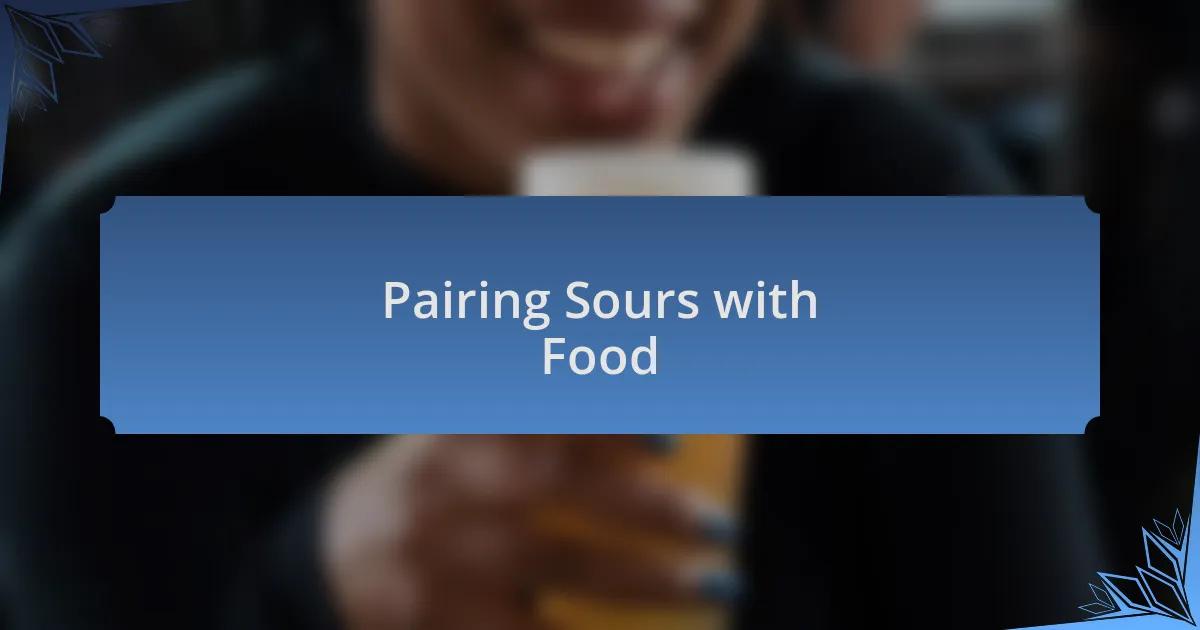Key takeaways:
- Craft beer festivals foster community and creativity, offering personal connections with brewers and diverse tasting experiences.
- Craft beers support local economies and promote sustainability, with each brew reflecting the brewer’s journey and cultural influences.
- Sour beers offer unique flavors and complex profiles, showcasing diverse fermentation techniques and aging potential.
- Enjoying sours can be enhanced through appropriate glassware, temperature, and thoughtful food pairings that highlight their acidity and flavors.

Understanding Craft Beer Festivals
Craft beer festivals are a vibrant celebration of creativity and community in the brewing world. I remember the first time I stepped into one; the air was thick with the aroma of hops and malt, and I felt an immediate sense of belonging among fellow enthusiasts. Have you ever noticed how these events bring together people from all walks of life, united by a shared passion for unique flavors?
At a craft beer festival, you’re not just tasting beer; you’re engaging with the stories behind each brew. I often find myself chatting with brewers, hearing about their journeys, and understanding what inspired their latest creation. This personal connection transforms each sip into a narrative, making the experience much richer. Isn’t it fascinating how a simple beverage can encapsulate the history and traditions of its maker?
Moreover, the variety of options at these festivals can be overwhelming yet exhilarating. I often think about how many styles I’ve yet to explore, each representing a different aspect of brewing mastery. It’s an opportunity to step outside your comfort zone and try something you might not typically choose. What’s more thrilling than discovering a new favorite beer while mingling with others who share that same adventurous spirit?

Importance of Craft Beers
Craft beers hold immense significance as they embody the art of brewing while supporting local economies. I often reminisce about how visiting a small brewery not only introduced me to unique flavors but also connected me with the community behind that brand. Isn’t it inspiring to think that each pint contributes to someone’s dream, often revitalizing neighborhoods and fostering local pride?
What captivates me most is the storytelling aspect of craft beers. Each bottle can illustrate a brewer’s journey, reflecting personal experiences and cultural influences. I’ve had moments where sipping a particular sour transport me back to a summer spent in a quaint coastal town, where the taste of the ocean mingled with the tang of citrus. Doesn’t that add an entirely new layer of enjoyment?
Furthermore, craft beers are crucial in promoting sustainability and innovation within the industry. I remember visiting a brewery that focused on using locally sourced ingredients, and it amazed me how their dedication to sustainability elevated their offerings. Isn’t it refreshing to know that by choosing craft, we’re often opting for environmentally friendly practices? This awareness not only enriches our drinking experience but also encourages a thoughtful approach to consumption.

Overview of Sour Beers
Sour beers are a fascinating category that diverges from traditional brewing methods. I recall my first encounter with a Berliner Weisse—its tangy fizz was unlike anything I had tasted before. It raised questions in my mind about fermentation; what made it so different? Exploring sour beers often feels like embarking on a taste adventure, as each sip can offer a complex, tart profile shaped by various wild yeast strains and bacteria.
The world of sours is diverse, ranging from the slightly sour to the intensely puckering. Walking through a craft beer festival, I vividly remember being intrigued by a table showcasing Lambics—each one telling a story of time and regional character. The layers of flavors often evoke nostalgia; a well-crafted sour can remind me of crisp autumn apples or the gentle tartness of summer berries. Have you ever felt so connected to a flavor that it pulls on your memories?
One of the most intriguing aspects of sour beers is their aging potential. I sometimes find myself drawn to the idea of patiently waiting for a barrel-aged sour to develop its intricate layers. The anticipation is palpable as I wonder how the flavors will mature over time. When someone shares a story about a vintage beer they’ve saved for years, it feels like I’m hearing about a treasure hunt—what a thrill it is to uncover something magical!

Key Techniques for Crafting Sours
Crafting sours requires a keen understanding of fermentation techniques. One key approach is the use of spontaneous fermentation, where wild yeast and bacteria from the environment are harnessed. I remember my first attempt at this method, placing my wort outdoors and feeling a mix of excitement and anxiety as nature took its course. It was fascinating to witness the unpredictability that came with every batch, yet it also highlighted the importance of patience in letting the flavors develop naturally.
Another vital technique is the incorporation of fruit during fermentation. Adding fresh or pureed fruits can enhance the complexity and aroma of your sour beer. I once experimented with raspberries, and the vibrant pink color that emerged was just intoxicating. How rewarding it was to see that luscious hue, reminding me of summer days spent picking berries, and ultimately tasting that sweet yet tart burst with every sip.
Lastly, barrel aging is a game-changer for many sour brewers. The unique character imparted by the wood, combined with the microbial life inside the barrel, can elevate flavors to an entirely new level. I still reminisce about a recent gathering where we shared a bottle of an aged sour that had been resting for over two years. Each pour revealed a medley of oak, vanilla, and tartness that danced on our palates, reminding me just how much time and environment play an essential role in crafting these delightful beers. What are your thoughts on this aging magic?

My Personal Brewing Journey
As I reflect on my brewing journey, I can’t help but share my first encounter with sour ales. It all began with a homebrew kit I received as a gift. I still remember the moment I cracked open that box and saw the array of ingredients. The promise of transforming simple components into something that sparkled with complexity thrilled me. It was a leap into the unknown, and honestly, that blend of anticipation and nervousness was electric.
My experiments grew bolder with each batch. One particularly memorable brewing session revolved around a blend of exotic spices and herbs. I remember the moment I added cardamom and ginger to the kettle, and the aromas released instantaneously filled my kitchen, conjuring memories of cozy family gatherings during the holidays. Did I worry I might be stepping too far outside the box? Absolutely. But embracing that uncertainty turned out to be one of the most rewarding aspects of my brewing adventure.
Then there’s the community aspect that made this journey so enriching. I attended my first craft beer festival, and it opened my eyes to the world of flavor possibilities, inspiring me to try different methods. I vividly recall chatting with a fellow brewer who shared his failed attempts at crafting sours. Instead of feeling discouraged, I was invigorated by his honesty—each setback was a stepping stone. How could I not feel inspired by the collective passion that united us as brewers? Those connections and shared stories became the backbone of my ongoing exploration in the world of sour beer.

Tips for Enjoying Sours
When it comes to enjoying sours, I find that the right glassware can significantly enhance your experience. I’ve noticed that using a tulip glass helps concentrate the aromas, allowing those tangy and fruity notes to hit your nose just right. Have you ever taken a deep breath before tasting? It’s like an invitation to the flavors waiting for you.
Temperature also plays a crucial role in savoring sour beers. I personally love to let my sours warm up a bit before drinking. There’s something magical that happens when those chilled notes come to life at slightly higher temperatures, revealing layers of complexity I hadn’t noticed cold. What’s your experience with temperature—do you prefer your sours served icy or at room temperature?
Pairing sours with food is another delightful tip I swear by. The acidity of these beers can cut through rich dishes, making them an excellent choice with creamy cheeses or spicy foods. I fondly recall one evening at a craft beer dinner, where a sour paired with a spicy curry brought out flavors I never expected. What have you paired with your sours that surprised you?

Pairing Sours with Food
The balance of flavors in sour beers makes them incredibly versatile for food pairings. One of my favorite combinations is a tart Berliner Weisse with fresh seafood. I remember enjoying a refreshing Berliner alongside some grilled shrimp, and the vibrant acidity seemed to enhance the natural sweetness of the shrimp. Have you ever tasted a beer that transformed your meal?
I also find that sours can elevate the experience of charcuterie boards. The tangy profile of a Flanders Red pairs wonderfully with cured meats and bold cheeses. I once hosted a tasting night, serving a Flanders Red with aged gouda, and the results were phenomenal. The beer’s complexity complemented the rich, nutty flavors of the cheese beautifully, creating a delicious harmony. What’s been your go-to pairing for from your board?
While many consider traditional wines for dessert pairings, I’ve had delightful experiences with sours as well. A fruit-forward sour can be the perfect companion for a chocolate dessert. I remember pairing a cherry sour with a chocolate tart, and the interplay of tart and sweet left a lasting impression on my palate. Have you explored the world of sours with desserts? The possibilities are truly exciting!